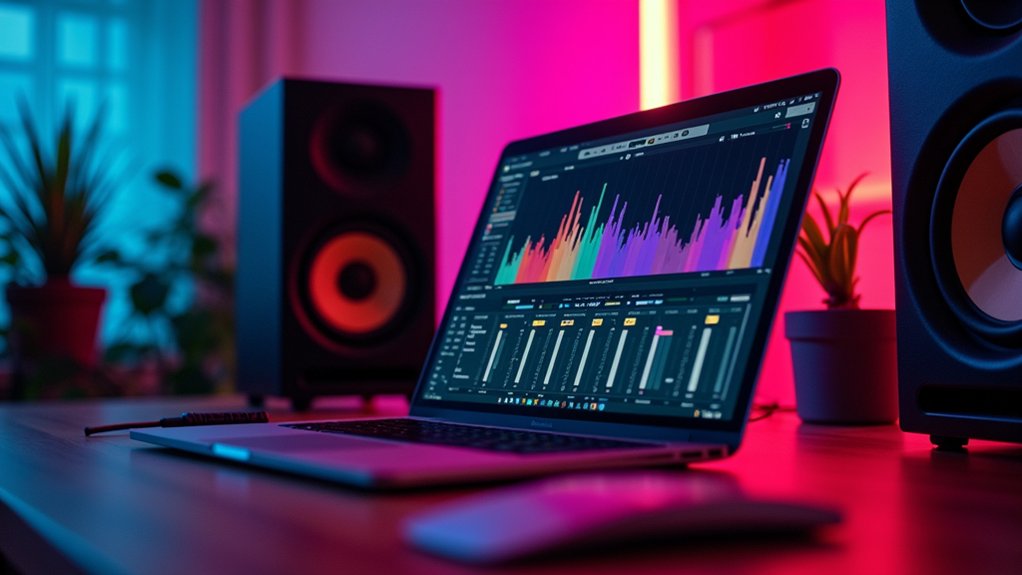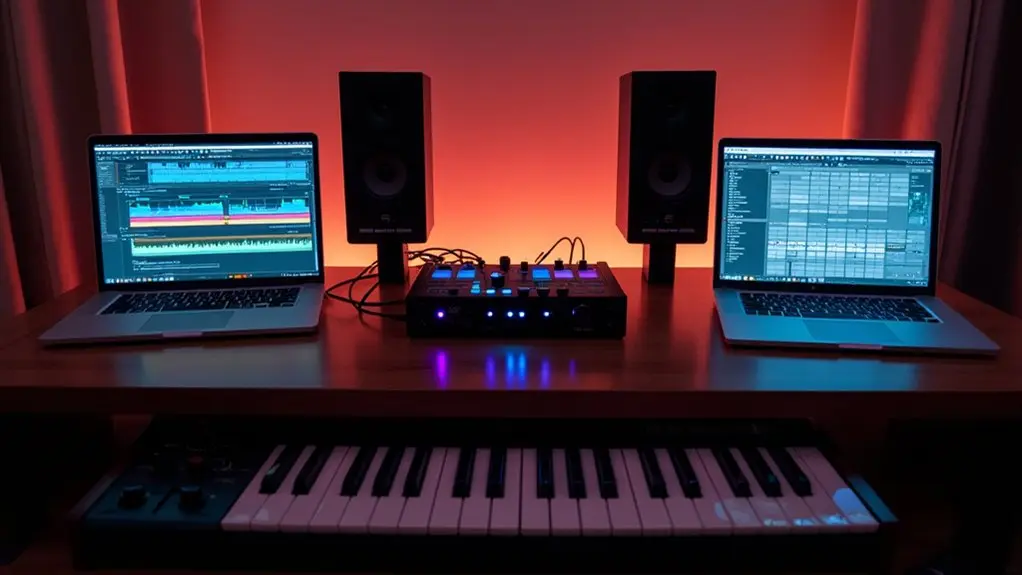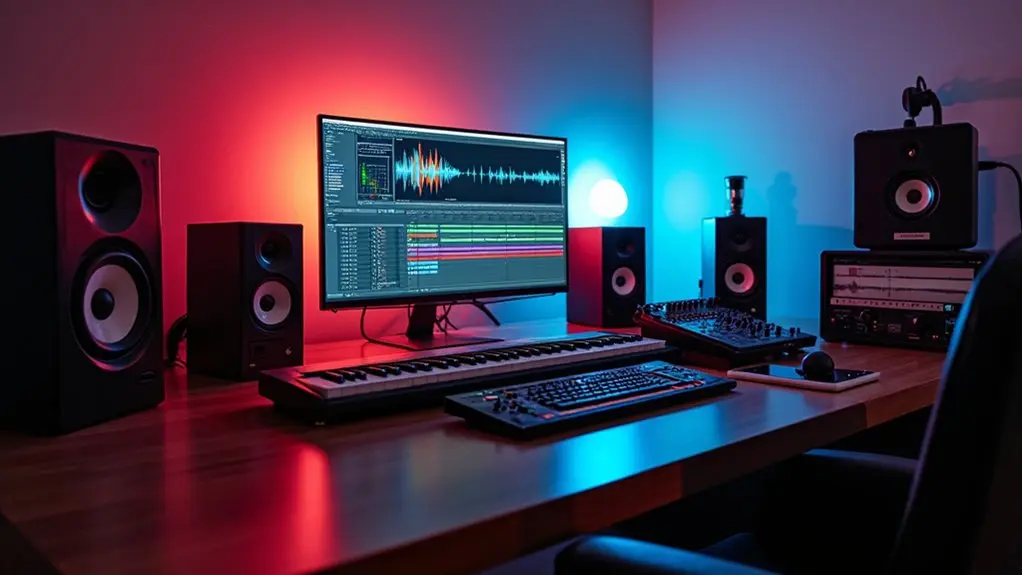Ableton’s Piano Roll enables precise MIDI editing by visually mapping note pitch vertically and timing horizontally. Users create, adjust, and duplicate MIDI notes via intuitive tools, with velocity and quantization settings refining expression and timing. Features like grid adjustment, Fold, and Scale streamline complex arrangements, while loop and playback controls aid efficient workflow. Advanced options such as Chance and Legato enhance dynamism. Further exploration of these tools reveals powerful techniques for optimized music production.
Key Takeaways
- Double-click inside a MIDI track to create or edit notes directly within the Piano Roll interface.
- Adjust note pitch and duration by dragging notes vertically (pitch) or horizontally (length) for precise placement.
- Use the grid and quantization options to snap notes to timing and maintain rhythmic accuracy.
- Modify note velocity and add expressive variation using the dedicated Velocity and Probability Editors.
- Activate the Fold and Scale features to focus on active notes and ensure harmonic consistency while editing.
Efficient MIDI editing begins with understanding the layout and customization options of the Piano Roll interface. In the MIDI Note Editor, the vertical axis visually represents note pitch with a piano keyboard, while the horizontal axis displays the timeline, enabling precise arrangement within a clip. Users can adjust the grid by right-clicking to select Adaptive or Fixed Grid, ensuring rhythmic accuracy when placing or editing notes. The Zoom functionality, accessed by dragging the window edges, allows detailed inspection of dense note passages or broader overviews. The Fold feature streamlines the workspace by displaying only active note pitches, reducing visual clutter. Additionally, the Scale button highlights all notes within a selected scale, which aids in maintaining harmonic consistency and quickly identifying relevant pitches during MIDI editing sessions. Mastering basic features like these optimizes the workflow, allowing for a smoother production experience.
Creating and Manipulating MIDI Notes
Once the Piano Roll interface is configured for ideal navigation and visibility, the process of constructing and editing MIDI data begins with the direct placement of notes.
In Ableton Live, users can double-click within a MIDI track’s Piano Roll to create a new MIDI note at any pitch and position. The note’s duration is adjusted by clicking and dragging its edges, enabling precise timing and phrasing.
Further manipulation is achieved by selecting notes and modifying their velocity in the dedicated Velocity Editor, directly influencing dynamics.
Advanced features streamline workflow and creative expression:
- Use the Legato feature to automatically extend notes, ensuring seamless connections.
- Employ the Probability Editor to introduce variation in note triggering and velocity.
- Select and move multiple notes simultaneously for efficient arrangement editing.
Additionally, mastering EQ and compression is crucial for enhancing the quality of your MIDI instruments and achieving a balanced mix.
Adjusting Grid, Quantization, and Velocity
Mastering the grid, quantization, and velocity settings within the Piano Roll is essential for precise MIDI editing and expressive sequencing. Adjusting grid size—by right-clicking and selecting Adaptive or Fixed Grid—enables accurate alignment of MIDI note(s) to desired rhythmic values, such as 16th or 8th notes. Quantization, accessible via right-click and Quantize Settings, snaps notes to the grid, enhancing timing consistency. Velocity editor functionality, found below the piano keyboard, allows users to click and drag vertical bars to modify note velocities; higher velocities yield louder sounds. The Velocity Range control can introduce dynamic variation by randomizing velocities within a set range. For further expressiveness, stretch markers can be used to adjust the note lengths, while Chance Editor lanes add variability in playback probability. Max for Live devices enhance quantization capabilities, especially useful for live performance, allowing for precise timing adjustments and a polished sound in music production.
Utilizing Advanced Features: Fold, Scale, and Chance
While basic MIDI editing covers essential parameters, advanced features in the Piano Roll—such as Fold, Scale, and Chance—provide powerful workflow enhancements for detailed sequencing.
The Fold function streamlines the editing process by displaying only active MIDI note(s), reducing visual clutter and making it easier to focus on relevant pitches, especially in dense MIDI tracks.
The Scale feature in Ableton Live 11 enables users to select a key and scale type, with 35 options available, highlighting only harmonically related notes for efficient melody and chord construction within the Arrangement View or while editing virtual instrument parts.
The Chance parameter injects controlled randomness into MIDI performances, with additional velocity range adjustment for greater expressive variation.
- Fold: Filter only used notes for precise selecting notes and editing.
- Scale: Highlight scale-conforming notes for harmonic accuracy.
- Chance: Randomize note triggering and velocity range for dynamic results.
Advanced techniques such as dynamic audio effects enhance soundscapes and track interaction, providing nuanced control over musical elements.
Playback, Looping, and Efficient Workflow Tips
Beyond advanced MIDI editing features like Fold, Scale, and Chance, efficient playback and looping management in the Piano Roll are fundamental for an optimized workflow.
In the MIDI Editor, utilizing the Follow switch guarantees the view scrolls in sync with playback, keeping editing focus on the active section. Looping tools and region controls permit precise selection and repetition of MIDI notes, and, when combined with shortcuts, greatly enhance navigation and editing efficiency.
Employing playback controls such as restart, stop, and scrub allows editors to audition sections instantly and maintain workflow momentum. Activating the Chase MIDI Notes command ensures note continuity when starting playback mid-phrase.
To access the piano roll, double-click a MIDI clip within a MIDI track to open it in the MIDI Editor, allowing you to rearrange, add, or delete notes. Mastery of these playback and looping strategies, alongside utilizing the scale feature, is key to advanced, uninterrupted MIDI editing.
Frequently Asked Questions
How to Use the Piano Roll in Ableton?
To use the piano roll in Ableton, users employ piano roll basics for MIDI note manipulation, apply velocity adjustment techniques, configure quantization settings, control note length, organize MIDI clips, integrate automation lanes, create chord progressions, design arpeggio patterns, and utilize visual feedback tools.
How Do You Turn a Piano Roll Into MIDI?
Turning a piano roll into MIDI involves using MIDI export methods, utilizing piano roll shortcuts, applying MIDI quantization techniques, adjusting MIDI note velocities, configuring piano roll grid settings, looping MIDI clips, layering parts, and integrating MIDI effects for enhanced expression.
How Do I Use the Piano Keyboard in Ableton?
To utilize the piano keyboard in Ableton, users employ piano keyboard shortcuts for efficient note input, adjust MIDI input settings, integrate virtual instruments, apply key mapping techniques, modify note length, edit velocity, use chord progression tools, apply scale quantization methods, leverage live performance features, and utilize MIDI effects.
Does Ableton Have a Good Piano Roll?
Ableton’s piano roll features advanced MIDI editing tips, robust note quantization techniques, visual piano roll customization, and seamless MIDI effects integration. Ableton shortcuts, workflow optimization methods, and music arrangement strategies support efficient sound design possibilities for professional and creative compositions.
Conclusion
Mastering Ableton’s piano roll enables precise MIDI editing through efficient navigation, customization, and manipulation of notes. Utilizing features like grid adjustment, quantization, velocity editing, Fold, Scale, and Chance streamlines the workflow and enhances creative possibilities. Incorporating playback and looping techniques further optimizes session productivity. By integrating these technical tools and strategies, users can achieve detailed control over MIDI composition, facilitating professional, expressive, and efficient music production within Ableton Live’s environment.




